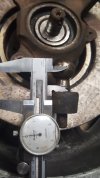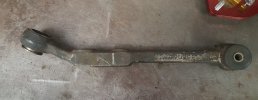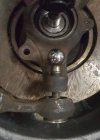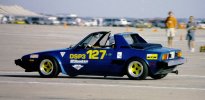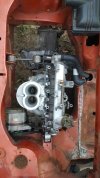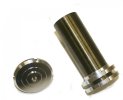fiatfactory
Steve Cecchele
@Paul Valente they are some very interesting solutions.... complex , but interesting.
I spent some time today doing some measuring and figuring, I was stuffed as why my virtual LCA length by calculation / layout on the floor and Gregs measurement were so different. That's why I re drew my layout again, and tried to make an allowance for the caster offset etc as I was drawing everything in 2D.
So today I made a gound line, a thick piece of 6mm plate steel (which is for the roll cage mounting plates) and put it under the front of my car (which is on a table) so I had a level ground line point to measure down to.
As soon as I started re assembling the suspension and checking caster angle etc, and moving the wheel thru a range of motion I realised several things.
in 3D as the wheel moves up and down, if you look at the wheel side on, the centreline doesn't move straight up and down, due to the 6 degrees of caster (and possibly the strut inclination as well) that point travels thru quite an arc, certainly not a straight up and down line.
The same can be said for the ball joint position, but not only does this point move thru space in an arc in the X axis, it also moves thru an arc in th Y axis...so as you lower the car, the virtual LCA length gets longer (until the pivot point axis' are level with the ground line)
My measurement when I laid out the front on plan of pick up points/pivots was done using standard ride height (error number 1) based on 145/80/13 tyres. we don't intend to have the lower control arm angled down at all, so there is one gain to the virtual length over my layout 240mm virtual LCA measurement measurement.
next was small error number 2, I plotted everything at zero camber to make it easy for myself drawing right angles evrerywhere.
Next is the big error number 3, I did some trigonometry based on a few rough guess numbers and added 5mm to my layout LCA figure... today I had carpenters squares and string lines pulled tight going in all directions and was able to get some real numbers..
with suspension assembled (a rim but no tyre fitted) I was able to set my suspension (no springs) at ride height (this is all based on standard top pivot position too BTW, I just used a standard top mount bolted to the standard turret for this) and plot down to my ground line plate with some reasonable accuracy as there was quite good access, and my trigonometry additions and adjustments (using the correct numbers) concurs with what I plotted out within 1mm
So I think a very safe number for virtual LCA with the control arm sitting level and the strut caster / camber is allowed for is 265.5mm (+-0.5mm)
The other thing that sort of stood out playing with the 2D programme was the importance of tyre aspect ratio on ride height settings, mainly because it affects the vertical position of the wheel side pivot of the LCA, (the ball joint) relative to groundline.
This got me thinking about the next most effective change to make to try lower the chassis / maintain good geometry (keep the LCAl level between the pivot points. would be to try alter the ball joint pivot point to position it lower relative to wheel centre line...so thats the next thing to look at., as well as making the LCA adjustable for length, as a litle modelling shows extra LCA length could be a good thng (like all things to a point)
But given the limitations of the online 2D modelling, it still (even with some incorrect data to start with) does show trends that occur when you move certain points around, which was mostly the object of the exercise in my case, and sort of served it's purpose for now.
For example there is a relationship between the upper pivot height and the pivots distance from centreline that definitely has a "sweet spot", and that sweet spot changes depending on the ride height setting... certainly something I probaly wouldn't have worked out so easily without playing with the online 2d model
but to get into any true development of the chassis I think Steve H is absolutely correct in that you need (really) good data and a good 3D modelling programme to get a true picture of what is happening - not just with camber curves and roll centre position, but what really matters which is the weight transfer across the chassis / tyres.
Fortunately a friend of a friend (who I rang today to get him to ask) has a 3d suspension modelling programme, so I'll find out what he has soon and see if he's keen on giving me a hand to map / plot things properly too.
SteveC
I spent some time today doing some measuring and figuring, I was stuffed as why my virtual LCA length by calculation / layout on the floor and Gregs measurement were so different. That's why I re drew my layout again, and tried to make an allowance for the caster offset etc as I was drawing everything in 2D.
So today I made a gound line, a thick piece of 6mm plate steel (which is for the roll cage mounting plates) and put it under the front of my car (which is on a table) so I had a level ground line point to measure down to.
As soon as I started re assembling the suspension and checking caster angle etc, and moving the wheel thru a range of motion I realised several things.
in 3D as the wheel moves up and down, if you look at the wheel side on, the centreline doesn't move straight up and down, due to the 6 degrees of caster (and possibly the strut inclination as well) that point travels thru quite an arc, certainly not a straight up and down line.
The same can be said for the ball joint position, but not only does this point move thru space in an arc in the X axis, it also moves thru an arc in th Y axis...so as you lower the car, the virtual LCA length gets longer (until the pivot point axis' are level with the ground line)
My measurement when I laid out the front on plan of pick up points/pivots was done using standard ride height (error number 1) based on 145/80/13 tyres. we don't intend to have the lower control arm angled down at all, so there is one gain to the virtual length over my layout 240mm virtual LCA measurement measurement.
next was small error number 2, I plotted everything at zero camber to make it easy for myself drawing right angles evrerywhere.
Next is the big error number 3, I did some trigonometry based on a few rough guess numbers and added 5mm to my layout LCA figure... today I had carpenters squares and string lines pulled tight going in all directions and was able to get some real numbers..
with suspension assembled (a rim but no tyre fitted) I was able to set my suspension (no springs) at ride height (this is all based on standard top pivot position too BTW, I just used a standard top mount bolted to the standard turret for this) and plot down to my ground line plate with some reasonable accuracy as there was quite good access, and my trigonometry additions and adjustments (using the correct numbers) concurs with what I plotted out within 1mm
So I think a very safe number for virtual LCA with the control arm sitting level and the strut caster / camber is allowed for is 265.5mm (+-0.5mm)
The other thing that sort of stood out playing with the 2D programme was the importance of tyre aspect ratio on ride height settings, mainly because it affects the vertical position of the wheel side pivot of the LCA, (the ball joint) relative to groundline.
This got me thinking about the next most effective change to make to try lower the chassis / maintain good geometry (keep the LCAl level between the pivot points. would be to try alter the ball joint pivot point to position it lower relative to wheel centre line...so thats the next thing to look at., as well as making the LCA adjustable for length, as a litle modelling shows extra LCA length could be a good thng (like all things to a point)
But given the limitations of the online 2D modelling, it still (even with some incorrect data to start with) does show trends that occur when you move certain points around, which was mostly the object of the exercise in my case, and sort of served it's purpose for now.
For example there is a relationship between the upper pivot height and the pivots distance from centreline that definitely has a "sweet spot", and that sweet spot changes depending on the ride height setting... certainly something I probaly wouldn't have worked out so easily without playing with the online 2d model
but to get into any true development of the chassis I think Steve H is absolutely correct in that you need (really) good data and a good 3D modelling programme to get a true picture of what is happening - not just with camber curves and roll centre position, but what really matters which is the weight transfer across the chassis / tyres.
Fortunately a friend of a friend (who I rang today to get him to ask) has a 3d suspension modelling programme, so I'll find out what he has soon and see if he's keen on giving me a hand to map / plot things properly too.
SteveC
Last edited:

